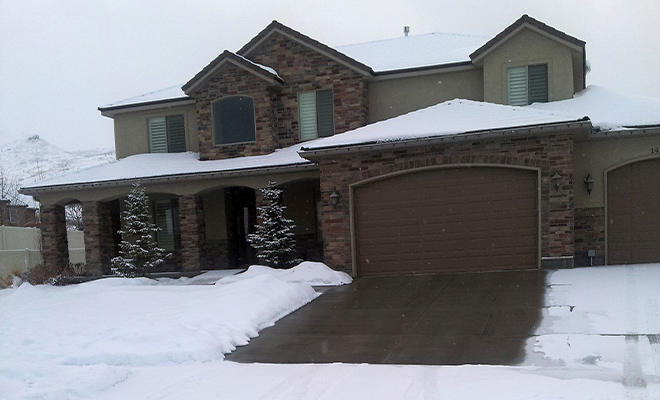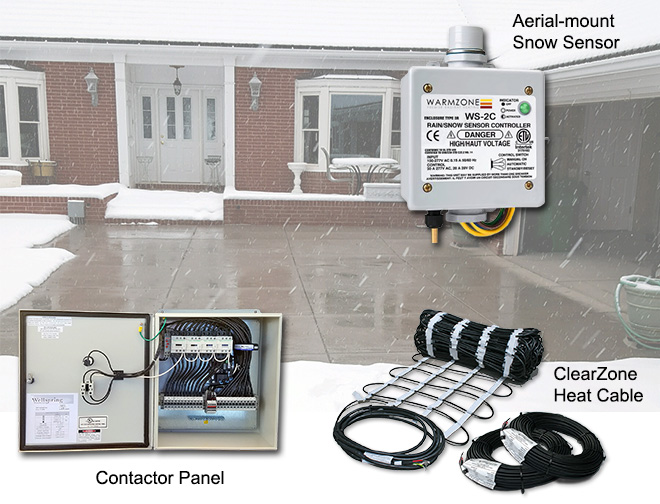Knowing What to Look for When Shopping for a Radiant Heat Snow Melting System
This winter I’ve been enjoying my heated driveway like a little country boy enjoying a Red Ryder BB gun on Christmas morning. This is the gift that keeps on giving, and every snowy day seems a little like Christmas. I feel like a proud father as I watch my heated driveway distinguish itself from all the other driveways in the neighborhood. Oh, and there’s Bob, shoveling snow from his driveway. ‘Atta boy, Bob.’ I nod and acknowledge him with a raise of my coffee cup. I know he can’t see me, but still, this is oddly satisfying. Ah, but I’m not here to gloat over my snow-free driveway.
I’ve learned a lot about radiant heat this past year. As a homeowner, I wanted to share what I’ve learned about driveway heating systems. Perhaps some of my experiences can be beneficial to others who are exploring the possibility of installing a radiant heat system.
When my wife and I first decided that we wanted a radiant heated driveway, we knew very little about the actual systems. I figured that the driveway gets warm, the snow melts, and boom, there it is. But the reality of it is that there are certain components and support services that make a big difference. I was fortunate in dealing with Warmzone. With that being said, I guess my first piece of advice to homeowners is to make sure that you deal with experienced, established pros. (There are cheap options out there, like buying generic heat cable from some home improvement store, but when you don’t have customer support services, it ultimately costs you more in the long run.) A heated driveway is a significant investment. Don’t cut corners.
These systems are touted as fully automated and maintenance free. This almost sounded too good to be true, but it is actually the case. Once installed, you really don’t have to worry about it. However, I like to wipe down the snow sensor every now and then. During the year, wind storms can kick up dust or leaves that may end up on the small sensor. To be honest, I haven’t had a leaf land perfectly on the sensor, but one never knows. Regardless, I like to wipe the sensor plate down now and then, just to avoid any dirt buildup.

In addition to the snow sensor, automated heated driveways also feature a heating element and control panel. Make sure the components for your system are proven products. Warmzone uses ClearZone heat cable, which has been around for decades, so I know it’s a cable I can trust. It also carries a top manufacturer warranty. The contactor panel, or controller is what kicks the power to the heat cable. The sensor detects snow, signals the controller, and then power is sent to the heating element that’s embedded in the driveway. It’s a simple system with no moving parts. Gotta love that.
Before I looked into getting a heated driveway, I didn’t realize that heat cable can be purchased in individual lengths off a spool, as well as in mats. I chose the mats. These are available in different lengths as well, but the cable is already pre-spaced, so they can simply be rolled out during the installation, and then secured. Boom! Pretty quick and easy. I was even able to help install them.
I’m really not much of a “do-it-yourselfer”, but this was something that even I could do. (I had my wife take a couple of photos of me “installing” the driveway, just for posterity’s sake – and to document my diverse skills.) Yeah, it was a proud moment, unlike the time I tried to show off my handyman skills by switching out a water facet in my wife’s apartment before we got married. (Be sure to always turn off the water supply beforehand.) But hey, she still married me. I guess I might still be trying to redeem myself for that one.
Anyway, to heat our concrete driveway, thin remesh was laid out and then the cable mats were placed over the remesh and then secured with plastic ties. (Did I mention that I did this part?) Little plastic supports, called Mesh-Ups were used to keep the remesh from resting on the ground. This ensures that the heat cable is ideally positioned about 2-3 inches from the surface of the finished driveway. Then the concrete was poured.
I also learned that heated driveways are designed according to ASHRAE standards. (Don’t worry, I had no clue what this meant either.) In other words, your driveway heating system will be designed specifically for the winter conditions in your area. If you have an average winter temperature of 24°F, with annual snowfall around 70 inches, then the designers create a system that is specifically designed to handle those conditions. This helps to determine the watts per square foot that your system needs to effectively keep the driveway clear of snow and ice. Each system is custom tailored to deal with the customer’s unique demands.

As you’re shopping for a system, ask questions. I’m glad I did. And be sure to have your electrician find out about the power requirements. (This usually isn’t a problem for most homeowners, but for those who are looking to heat massive areas, you should definitely find out what your available power is, and confirm the system’s power demands.)
Fortunately, snow melting systems can be customized to the hilt, so you can install radiant heat exactly how you want. If you don’t want to heat your entire driveway, then you can heat two 24-inch wide tire tracks, or just an 8-foot wide strip in the middle. Heck, you can install radiant heat in a checkerboard pattern if you want. It’s all about you and what works best for your layout and budget.
Also, perhaps the most important services for customers are the support services such as free installation training, technical support, and system design. The free installation training was invaluable. The instructor covered every aspect of the installation, so the electrician and installers knew everything they needed, prior to installing the system. Warmzone also provided real time technical support. When the electrician had a question, he called and spoke with an expert. Also, prior to any work taking place, Warmzone created a detailed layout / design of the system. We knew exactly how and where to install the heat cable and every component. These support services are what made the difference. I can’t stress enough that you deal only with a company that provides these types of services.
My advice to you is to call and talk with a radiant heat expert and explore your options. (Oh, and remember to always turn off the water supply before changing water facets.) Warmzone radiant heat experts are friendly professionals who will ask you about your project and then explain the best available options. There’s no rush, and no pressure. I talked with these guys for months before my wife and I decided to do the installation. They were always there to patiently answer any questions or address any concerns. Given their quality products and remarkable support services, I couldn’t imagine working with any provider other than Warmzone.
Warmzone is one of the largest providers of floor heating, snow melting, and roof de-icing systems, as well as luxury home heating amenities. For more information about Warmzone radiant heat systems or luxury amenities, contact a friendly Warmzone representative today, at 888-488-9276.
